Graham Reid | | 12 min read
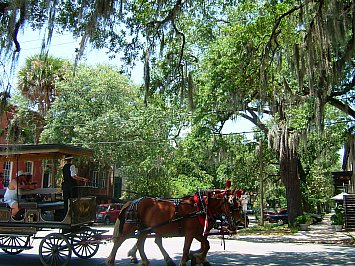
Mary's words float, wisps of cloud in this hot Georgia afternoon. She speaks in a charming, slow drawl, her voice rarely rising with inflection. We walk through Columbia Square in the old heart of Savannah where Spanish moss hangs like whispers from dogwood trees.
"Now, we had a gennel-man down he-ya one tahm recently," she says, her words dragging like slow woodsmoke in the still sky, "and he said to me we must have had an aww-fully hah tide.
"He thought this," she gestures toward the dripping threads of pale moss with an airy wave, "was sea weed."
After our laughter has ceased she turns and, with a smile possessed of all the glacial beauty and warmth of an icicle, adds: "He was . . . an in-lander."
Then, after a long pause, she delivers the withering kiss-off: "Some of them ah not very braaaght."
Mary is a southern belle, at sixtysomething as soft as a caress on a summer's night, as hard as an iron nail buried in an oak barrel. A throwaway line from a belle can have a devastating effect, it can turn "in-lander" into a damning epithet. Such women, steel magnolias as they are known, are legendary in the south.
When the Union's General William
Tecumseh Sherman made his notoriously incendiary march through the
south at the fag end of the Civil War he noted the fortitude of such
womenfolk in Savannah, a city he occupied for six weeks and didn't
much care for. "You women are the toughest set I ever knew,"
he said. "The men would have given up long ago but for you."
Sherman's march is literally scorched into Georgia's history. Starting in March 1864 his Northern troops cut a 60 mile wide swathe across the state, burning Atlanta along the way, then halting outside Savannah in December with 60,000 troops and numberless camp-followers ready to lay waste to the historic riverside city with its mansions and beautiful parks. The astute burgers of Savannah were pragmatic businessmen however and, fearful of what fiery fate awaited, sent out envoys to negotiate.
It was simple deal: the city would surrender if he didn't burn it. Sherman was a contrary and unreliable man and there was no guarantee he'd accept such an eloquently simple proposal. But he did and sent his famous telegram to president Abraham Lincoln offering him the city intact as a Christmas present.
Sherman's troops only stayed a month in the city, during which time they looted houses for timber, knocked down gravestones in Colonial Park Cemetery where they set up camp and chipped the dates off graves, among other infractions.
Then, fortified and rested, they marched off to Columbia in South Carolina where Sherman promised the mayor that "not a finger's breadth" of his city would be harmed and its citizens could sleep safely.
When he left three days later half of Columbia was a charred ruin.
"If the people raise a great howl against my barbarity and cruelty," said the great general, "I will answer that war is war, not popularity."
Later in life Sherman offered the more conciliatory opinion of battle. "War is hell" he famously said, a quote which deserves to be repeated in full: "I am sick and tired of war. It's glory is all moonshine. It is only those who have neither fired a shot nor heard the shrieks and groans of the wounded who cry aloud for blood, for vengeance, for desolation. War is hell."
When he arrived on Savannah's doorstep however he wasn't in quite that frame of mind.
What Sherman and his pyromaniac troops didn't destroy in Savannah however time and indifference did. By the middle of last century many of the once stately homes in this historic riverside town just 17 miles from the Atlantic were falling into decay and disrepair. The tragedy was compounded by the city being of such a beautiful, formal and practical design.
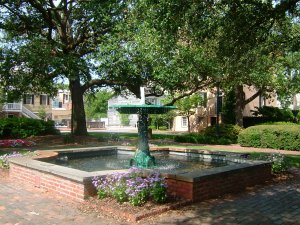
The impossibility of his ethos aside -- although the injunction against lawyers is still especially admirable -- his banning of slavery would have made Savannah unique in southern culture. But within a couple of decades his city above the river would be surrounded by plantation culture and slavery became endemic. Yet something of his spirit remains in the soft air.
But if Oglethorpe's social vision faltered his civic design assured Savannah's future as a leisurely and -- in today's parlance, laid-back -- city. The Historic District -- beyond which Savannah trickles off into large wooden suburban homes and then the usual flatland-city sprawl -- is built around 21 squares with common ground at their centre.
Viewed from above the old town looks like an elegant French garden under the eye of the Sun King.
This is where we are walking with the formidable and charming Mary, fearful we might betray ourselves as "in-landers" or worse. She explains how three sides of the squares were given over to housing with a public building, "a church or such-laahk", on the other.
We are standing outside the restored Davenport House, now a museum. We have walked the quiet avenues where cars and tour buses are slowed by the sedate squares with their statuary and park benches. A police roadblock a block north of Columbia Square -- "Terrorists, or kids" someone says with an admirably lazy lack of alarm -- has effectively pulled these streets into silence. One police vehicle on one corner and the square is deserted.
What a civilised city, we say as we walk beneath ancient oaks as Mary lulls us with anecdotes and her seductive voice. The Davenport House is a time portal back to the 1820s.
We step back through history up the curved steps to the front door -- Savannah's stately homes provided their occupants with privacy from passers-by -- and are in the long hallway which, typically, bisects such homes. It has Roman columns, and at the far end a stairwell curves to the upper floor. We walk lightly through these silent rooms as Mary tells her story: how builder Isaiah Davenport became a wealthy man and constructed this house for his growing family (10 children, three of whom died in infancy) and died in 1827 at 43.
How for the next 13 years his wife took in boarders to keep the house, how by the end of the century the area had become rundown and the place was turned into a tenement block, sometimes with a dozen families in occupation.
By 1955 it was a dump and was bought by a neighbour Mrs Summerlin who wanted to knock it down -- "she probably could have pushed it over," says Mary -- and use it for parking. Her plan outraged other local women still smarting from the loss of the historic City Market -- "they put a parking lot there and wanted to call it City Market Parking," sniffs Mary -- and they formed the Historic Savannah Foundation, then raised money and bought the property with the intention of restoring it. The place was gutted and refurbished, and opened as a museum in 1963.
These
days over 70,000 visitors a year peep through its stateliness and its
brochure proudly banners "Where Savannah's preservation began".
Later we walk back to our hotel, the gorgeous 17Hundred90 Inn on East President St just around the corner. Its dark and intimate bar and restaurant are famous in Savannah. It also has a ghost, of unfortunate Anna Powers who apparently fell in love with a married seaman and who, in a fit of depression when he sailed away, threw herself from the third floor balcony onto the courtyard below.
She haunts Room 204 and those around it.
We are in 205.
Savannah is full of ghosts -- there is
a popular Haunted History Tour -- and, to some extent, the Historic
District was in danger of becoming haunted houses staggering with
faltering steps into ruin.
By early last century many of the homes around here were decrepit and damaged, abandoned, or occupied by families for whom the words "repair" or "maintenance" came from a foreign tongue. It is overstating the case to say one man halted the slide, but certainly Savannah would not have been the same without Jim Williams. According to his sister Dr Dorothy Williams Kingery in her collection of Jim's essays, Savannah's Jim Williams and His Southern Houses, her brother fell in love with the city at first sight when he was 21.
Savannah was both his coming of age and his partner for life. He started restoring homes in a private capacity three years later in 1955, coincidentally the same year as the Historic Savannah Foundation was launched.
He was a man who loved and respected old things, an antique collector who restored old homes around Savannah and South Carolina with a rare passion and an eye for detail. Williams would hoard pieces of derelict homes waiting for the opportunity to use them in appropriate locations. When "progress" overtook the Historic District in the 60s in the form of carpark buildings or other modern eyesores around Oglethorpe's restful squares Williams would scavenge up whole rooms from houses being demolished.
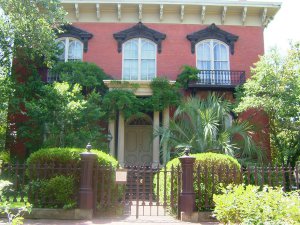
Stepping up and inside from the sunken garden we feel like we are walking on hallowed ground. But we are not alone. Mercer House is a magnet, and not just for those with an interest in restoration, Faberge and fragile Chinese porcelain.
Williams might have remained a local legend and known elsewhere only by those at the high end of the antique trade were it not for John Berendt's extraordinary book Midnight in the Garden of Good and Evil, a non-fiction novel in the manner of Truman Capote's In Cold Blood. In Savannah it is simply known as "The Book" and it lifted the lid on a seamy if beguiling side of the city which revealed it's eccentricities, sexual peccadillos, and the old town's almost utter indifference to outsiders and change.
It also exposed the famous murder trial at which Williams was accused of shooting his young lover, the wild and dangerous Danny Hansford, in the house in 1981. After four trials and eventually being acquitted Williams died of a heart attack a few months later in the same room, falling to the floor at the spot from where he shot Hansford.
Berendt's anecdotal but increasingly compelling story is part travelogue, part profile of a society world within a seductive city, and part murder mystery. It spawned a Clint Eastwood-directed movie starring Kevin Spacey, a sell-through video Midnight in Savannah, and the city offers a two hour "Book" tour which takes in the cemetery where the voodoo priestess Minerva practiced her dark art, the club made famous by the lady-boy Lady Chablis and the soda-fountain shop where the oddball Luther Driggers would go for breakfast.
The good citizens of Savannah have reluctantly tolerated the tourism “The Book” has brought, but largely try to ignore it and the visitors, much as they have done any intrusion from outside. Mention of it is likely to bring a Southern sigh of weariness.
Lady Chablis however was quick to capitalise on the notoriety/fame which "The Book" brought her. The former Miss Gay World -- who lives off-stage as a woman -- hit the talkshow circuit of Oprah and Good Morning America and was offered a six-figure sum for her autobiography Hiding My Candy which appeared only two years after the Berendt book in 1996.
Hers was a remarkable story: born into poverty in Florida in 57, she grew up with her grandmother and aunt and early in life realised that she was not a "boy". She moved in with her mother and stepfather when she was nine and was beaten mercilessly for years. She ran away from home at 16 and adopted the name Chablis.
Drugs took over, she performed in cabaret throughout Georgia, and her show "Lady Chablis and Her Men in Motion" strip show was hugely popular. Berendt's book introduced her to the wider world and her book -- which came with innuendo-heavy recipes -- attracted the interest of film companies. She became a minor celebrity and tourists flocked to the Savannah club where she worked.
"The Book" has been good for tourism and it is a story of intrigue and voodoo, art and artifice, characters and cocktail parties.
And much of it took place in or around Mercer House, built for the great-grandfather of the songwriter Johnny Mercer.
The Mercer-Williams House stands on the western side of Monterey Square at 429 Bull St. Many myths surround the house, not the least is that the great Johnny Mercer -- who wrote the wistful words to Henry Mancini's music of Moon River, among hundreds of other lyrics -- used to live here. He didn't -- and nor did his great-grandfather Hugh Weadon Mercer. In fact no Mercer has ever lived in Mercer House.
Designed by John Norris, it is an intelligent amalgam of Greek and Italianate style, with Renaissance Revival elements. Yet it was lucky to survive its difficult birth. According to contemporary reports Sherman's troops progressively stripped Mercer House of its beams and window frames to erect their shanty houses in the nearby squares.
After the Civil War Mercer -- who had risen to general in the Confederacy but was threatened with a court martial for shooting deserters -- sold the property. It's construction was completed by one of Norris' assistants. It passed through many hands in the subsequent century but when Williams bought it in 1969 it had been standing empty for a decade. And so he began his two year project to bring it back to its stately potential. With typical elegance he opened it with a gala Christmas party, which became an annual tradition.
Today the Mercer House is correctly referred to as the Mercer-Williams House, it's gardens and grandeur now open to the public, but under the strictest of supervision: there is a conducted tour from the gift shop, no photos inside, no access to the upstairs rooms. Even so, the Mercer-Williams House is impressive. Our guide ushers us up from the small sunken garden with its terraced, grey bricks and slate pathway surrounded by banana trees and ferns and we stand beneath a fan on the back porch in the seeping heat.
The house, of red brick, has soaring 15 foot high ceilings and towering windows which come down to floor level which you can open and walk through. The 60 foot entrance hallway with its original ceramic tiles from Stoke-on-Trent in England, allows for a gentle through breeze on Savannah's hotter days, and the place has the air of graceful comfort and poise. Our attention is directed to the magnificent stained glass dome in the ceiling which was intact when Williams bought the house although the framing was rotting and it was perilously close to falling out.
Over there is the mahogany stair rail carved by shipbuilders in Maine, through this massive door the living area with its French candelabrum on the mantle, the chinoiserie cabinet, the bust of the Princess Victoria ... Williams was no purist when it came to aesthetics: American and English portraiture from the 18th and 19th century occupies the same space as Chinese porcelain, ivory tusks and shells picked off the beach of Cabbage Island on the coast.
Yet the odd juxtapositions somehow work and the house -- which really does feel like a home, albeit an elegant and scrupulously tidy one -- seems all of a piece, the work of single, creative mind. We hear of famous guests who have been here: General Colin Powell, Ladybird Johnson, Margaret Thatcher, Jackie Kennedy Onassis ...
But in truth it is "the Book', that story, that notoriety, which has brought our small party here in the steamy Savannah noonday heat.
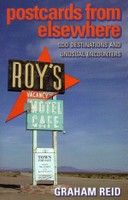 Curiously, given the giftshop in the
former carriage house where Williams used to restore furniture and
ran his antique shop has copies of "The Book" displayed
prominently, it is never mentioned by our charming docent as she
glides, Mary-like, through the quiet hall and stately rooms.
Eventually curiosity takes charge and Megan, daring to voice the
unspoken, asks cautiously if the elegant office we are standing in is
the one where Jim Williams died.
Curiously, given the giftshop in the
former carriage house where Williams used to restore furniture and
ran his antique shop has copies of "The Book" displayed
prominently, it is never mentioned by our charming docent as she
glides, Mary-like, through the quiet hall and stately rooms.
Eventually curiosity takes charge and Megan, daring to voice the
unspoken, asks cautiously if the elegant office we are standing in is
the one where Jim Williams died.
Her discretion at not mentioning the murder of Danny Hansford -- who must have bled here, on this spot which is now beneath the photograph of Kevin Spacey on the sideboard -- is to be admired.
But not rewarded.
There is a long silence, the warm breeze pushes whispering leaves against the window, other visitors crane forward to hear the hushed reply.
"Well, now ah don't know about that. I haven't ever asked and you know ... (long pause) ... ah don't think I'd want to know," she says sweetly.
Then smiles with all the glacial beauty and warmth of an icicle.
This story appeared in the travel collection Postcards From Elsewhere


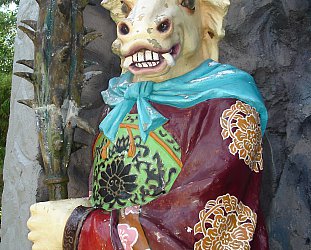

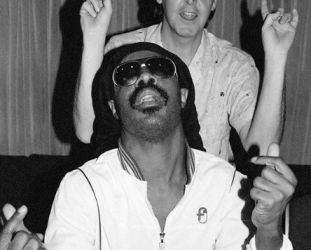
post a comment